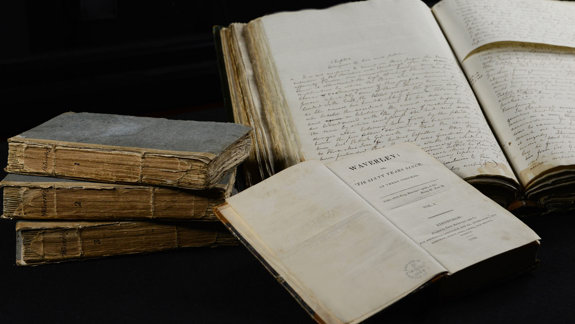John Buchan and 'The Thirty-Nine Steps'
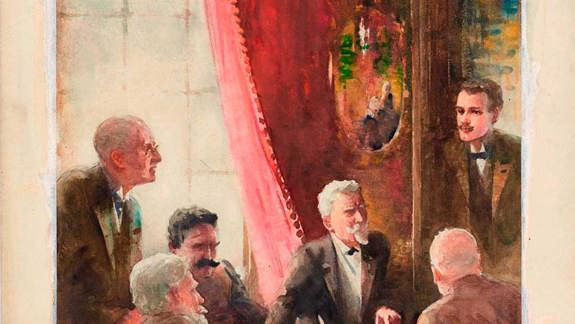
Introduction
Who was John Buchan?
A writer, politician and public servant, John Buchan was born on 26 August 1875 in Perth, Scotland. His father was a lively character who enjoyed singing border ballads and other Scots songs. His more reserved mother epitomised Free Church virtues. These contrasting attitudes to life made Buchan acutely aware of the importance of maintaining respectability, while appreciating that it's the world's eccentrics who get things done.
As a young boy, Buchan relished family holidays on his relatives' farm at Broughton, where he first became fascinated with the people of the Borders and its rivers, hills and shallow glens. Later on, these individuals and landscapes influenced much of Buchan's writing, including 'The Thirty-Nine Steps'.
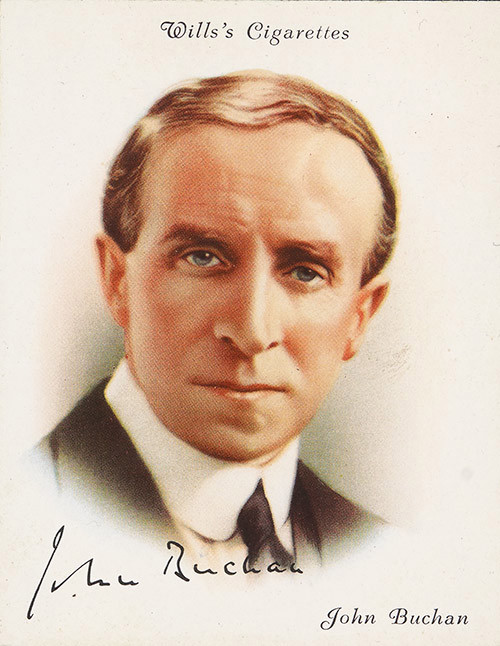
When the First World War broke out in 1914, Buchan was medically unfit for active service. He spent three months confined to bed and began to write a serialised history of the conflict, which was published by Thomas Nelson in 24 volumes. With each instalment around 50,000 words long, the work was marketed as "a readable narrative" and "an authoritative record for the future". While working on this major project, Buchan also embarked on a very different book: a slim spy thriller titled 'The Thirty-Nine Steps'.
Buchan later worked as a War correspondent for 'The Times' newspaper before joining the Foreign Office. He became a Member of Parliament and a peer and, in 1935, was sworn in as Governor General of Canada. Though a stickler for the rules of Government in his professional and public lives, Buchan parodied them in his novels.
Publishing 'The Thirty-Nine Steps'
Writing at the beginning of the First World War, Buchan found this side project a welcome distraction from the realities of world events.
"While pinned to my bed during the first months of war and compelled to keep my mind off too tragic realities, I gave myself to stories of adventure."
John Buchan in 'Memory Hold-The-Door: The Autobiography of John Buchan', 1940
'The Thirty-Nine Steps' was serialised in 'Blackwood's Magazine' in the summer of 1915, where it was credited to the pseudonym H. de V. The book version came out in October the same year under the author's own name and sold over 25,000 copies in its first three months. With a plot full of train travel, code-breaking, car crashes and political intrigue, the novel has remained in print ever since.
Is 'The Thirty-Nine Steps' based on a true story?
Buchan's story is pure fiction, but its success is due – in part – to its real-life setting. Buchan also chose a theme that allowed him to create a gripping thriller with an element of political subterfuge.
The novel's action takes place very precisely during a few weeks in May and June 1914, just before the outbreak of the First World War. And its hero, Scotsman Richard Hannay, is immediately caught up in a troublesome situation that exposes just how vulnerable Britain could be to foreign plots.
Throughout the book, Buchan holds Hannay up as an example of an ordinary man who puts his country's interests before his own safety. This patriotic stance, along with the page-turning plot, made the story a hit with soldiers stuck in the trenches of the First World War.
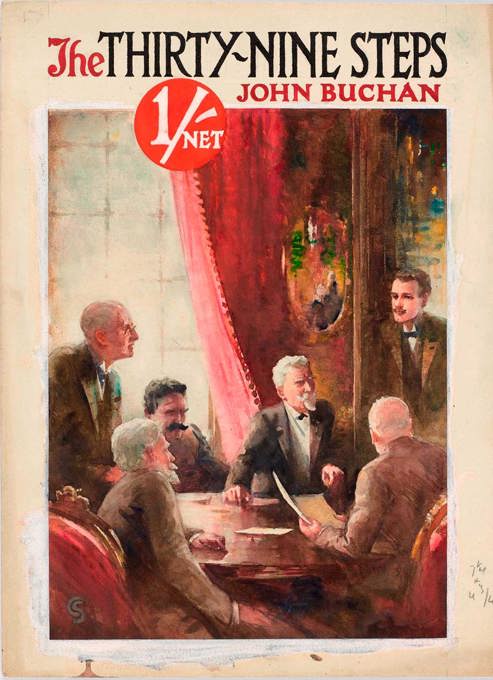
What is the plot of 'The Thirty-Nine Steps'?
From Hannay's point of view, he's nothing special. Newly returned from many years in Bulawayo (in what's now Zimbabwe), he describes himself as "an ordinary sort of fellow, not braver than other people" and "the best bored man in the United Kingdom". But he quickly becomes embroiled in a race against time to save himself and ensure that good prevails over evil.
The story begins when Hannay meets an American called Franklin P Scudder, who tells him about a German spy ring planning to sell British secrets. When Scudder is murdered in Hannay's London flat soon after, our hero fears for his own life, while worrying he might fall under suspicion of taking Scudder's. Eager to solve the mystery of the murder and the spy ring, he escapes to Scotland pursued by spies and the police.
After evading both in Scotland, Hannay heads for the Berkshire village of Artinswell, thought to be inspired by the real-life village of Kintbury, between Newbury and Hungerford. There he meets the Permanent Secretary at the Foreign Office and shares everything he knows.
Back in London, Hannay's name is cleared and he works with the authorities to track down the German spies. First, though, he must decode the meaning of "the thirty-nine steps", a phrase the murdered Scudder coined to describe the location of their intended escape.
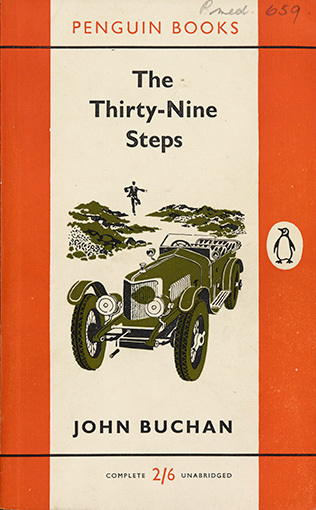
Scottish locations in 'The Thirty-Nine Steps'
Much of the action and excitement of 'The Thirty-Nine Steps' centres around Hannay's eventful journey from London to Scotland and an ensuing chase around Dumfries and Galloway in Western Scotland.
When Hannay first leaves his home in Portland Place, Marylebone, he plans his escape using a map of the British Isles and a copy of 'Bradshaw' (a railway guide). Disguising himself as a milkman, he makes a mad dash to St Pancras Station and boards a train bound for Scotland.
Hannay only decides on a specific destination when required to buy a ticket on the train. Travelling on the now defunct Midland Railway, he somehow remembers the name of Newton-Stewart, a small market town on the banks of the River Cree. As the train makes its way north, it passes through Leicestershire, Derbyshire and Yorkshire before crossing into Scotland.
Changing trains at Dumfries, Hannay boards a slow train to Galloway and disembarks at a station whose name he "scarcely noticed". And so begins a pursuit across Scottish moorland. Hannay travels by foot, train and car as the story and chase gather momentum. The action later moves to the Scottish Borders, where Hannay encounters the 'Spectacled Roadman' and the 'Bald Archaeologist'. He then catches a train from a junction near the town of Moffat, which takes him back south.
Although Buchan mentions local landmarks, like the Cairnsmore of Fleet hill and the Devil's Beef Tub hollow, his particular skill was in capturing and evoking the landscape and atmosphere of the Scotland he knew from his childhood holidays in the Scottish Borders.
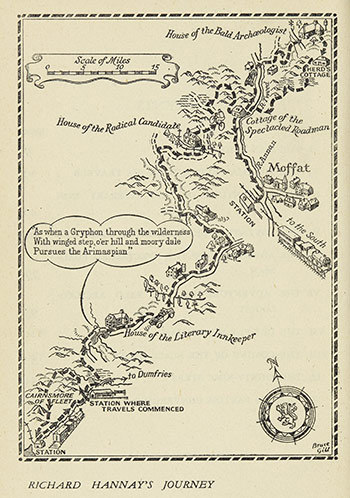
What are the 39 steps?
After Scudder is killed, Hannay discovers a notebook that he must have hidden in his apartment. Filled with notes written in a numerical cipher, it's impossible to read, but Hannay takes it with him when he goes on the run.
It takes a while for Hannay to break the cipher, but when he does he's puzzled by the phrase "thirty-nine steps", which appears half a dozen times in Scudder's notes. The final mention reads, "(Thirty-nine steps, I counted them – high tide 10.17PM)".
By the penultimate chapter of the book, when Hannay is back in London, he realises "thirty-nine steps" must be a clue to where the German spies will leave the country – somewhere the high tide occurs at 10.17PM.
"What did Scudder mean by steps? I thought of dock steps, but if he had meant that I didn't think he would have mentioned the number. It must be some place where there were several marked staircases, and one marked out from the others by having thirty-nine steps."
Richard Hannay in 'The Thirty-Nine Steps' by John Buchan, 1915
With time running out to prevent the spies' escape, Hannay consults tide tables, but this still leaves 50 or more possible locations for the steps. He looks up steamer sailings, but none are scheduled for 10.17PM. He wonders why the high tide is important and concludes that the steps must be near somewhere that has a small harbour or no harbour at all. He then works through all the options that might make sense for someone who wants to leave London for Germany without being seen.
Surmising the site must be "a piece of open coast with biggish cliffs, somewhere between the Wash and the Channel", Hannay asks for help from a coastguard with knowledge of the area. Together, they conclude that the escape point must be "the Ruff", a chalk headland close to the town of Bradgate in Kent. The coastguard tells Hannay there are villas on top of the headland, some with staircases down to a private beach. "It's a very high-toned sort of place", he says, "and the residents there like to keep by themselves".
Buchan's fictional coastal town of Bradgate was modelled on Broadstairs in Kent, where the author holidayed in 1914. The "steps" of the novel's title lead down to a beach just to the north of the town. Their destination – Stone Bay beach – is still a quiet spot today.
'The Thirty-Nine Steps' on stage and screen
Buchan's adventure novel inspired many adaptations, including film, theatre, comics and graphic novels. In 1935, Buchan sold the film rights to 'The Thirty-Nine Steps' for £800. Director Alfred Hitchcock, a fan of Buchan, used the 'man-on-the-run' theme to create a gripping and suspenseful narrative. The script, written by Charles Bennet and Ian Hay, introduced a music hall-turn, a cool blonde, handcuffs, and the Forth Bridge to the story. The black and white film 'The 39 Steps', starring Robert Donat and Madeleine Carroll, came out in 1935 and was a great success. Sixty-four years later a British Film Institute survey ranked it fourth in a list of the greatest British Films of the twentieth century.
'The Thirty-Nine Steps' is one of the earliest examples of the innocent 'person on the run' thriller genre. Hitchcock himself revisited this theme in later films. In 'Saboteur', an aircraft worker is forced to go on the run after being wrongly accused of starting a fire that kills his best friend. In 'North by Northwest' a man mistaken for someone else is pursued across the United States by agents from a mysterious organisation.
A colour film of 'The 39 Steps' was released in 1959, starring Kenneth More and directed by Ralph Thomas. This was followed by a 1978 version starring Robert Powell. Both were filmed in Scottish locations. Adaptations of the novel are not, however, limited to film. The story also spurned a radio drama starring Orson Welles, a feature-length BBC TV drama and an award-winning parody play, which ran in London's West End for nine years.
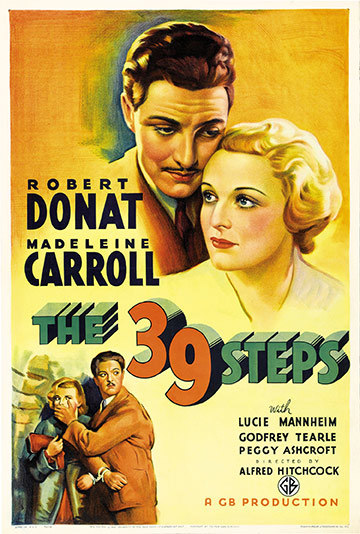
What else is John Buchan known for?
Buchan considered himself to have three personas. Publishing, he said, was his business, writing his amusement and politics his duty. His outlook in all three lives was inevitably shaped by a deep knowledge of the internal workings of the establishment at a time of fundamental change in British society.
The year after 'The Thirty-Nine Steps' was published, Buchan was working for the Commander in Chief of the British Expeditionary Force, General Haig, drafting official communications for the War and Foreign Offices. The same year, he became Second Lieutenant in the Intelligence Corps. It wasn't long before he was appointed Director of a new Department of Information, with direct responsibility to the Prime Minister.
In a 1927 by-election, Buchan was elected as the Unionist Party member for the Combined Scottish Universities, a constituency made up of the universities of Glasgow, Aberdeen, Edinburgh and St Andrews. At the time, the Unionist Party was the main centre-right political party in Scotland.
Words were Buchan's craft and his political communications echoed his literary talent. Many of his speeches touched on some of the most pressing political matters of his time, including women's suffrage and the future of unionism in Scotland. In a speech written around 1911 Buchan said he believed in some form of devolution across the United Kingdom as a means to mend its constitutional machinery and secure good government.
Buchan's fiction remained popular throughout the 20th century. Alongside biographies and histories, he published at least one popular novel every year until 1937. He produced four sequels to 'The Thirty-Nine Steps', numerous other adventure novels and historical fiction like 'Midwinter', which was set during the Jacobite Rising of 1745.
Life in Canada
In 1935 Buchan was made Baron Tweedsmuir of Elsfield and he accepted the appointment of Governor-General of Canada. By then disillusioned with British politics, Buchan encouraged greater cooperation with the USA, particularly given (another) impending war with Germany. He therefore cultivated diplomatic relations with the President of the United States Franklin D Roosevelt.
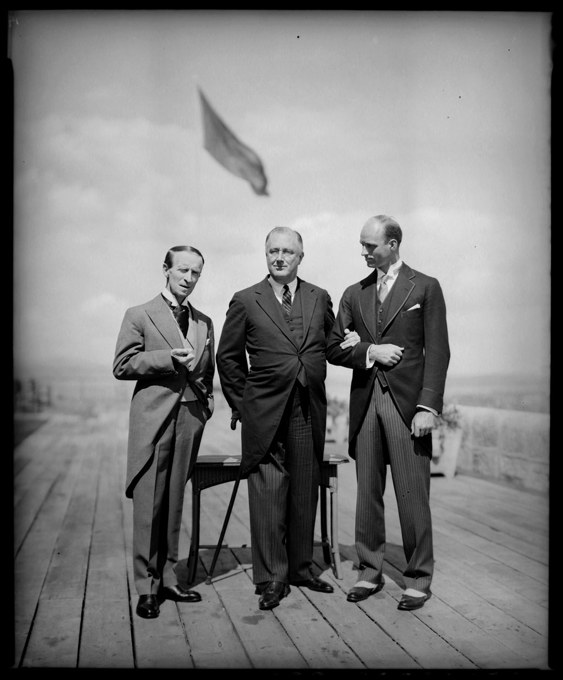
While living in Canada, Buchan indulged in life's simple pleasures, like skating, walking and reading. His final novel, 'Sick Heart River', was inspired by the Canadian Northern Territories.
On the outbreak of the Second World War, Buchan wrote in his diary, "This is my third war, a bit too much". The Anglo-Boer War, the Great War and the impending war with Germany had dominated his adult life, fuelled his writing and influenced his contribution to the public sphere.
On 6 February 1940 Buchan suffered a cerebral thrombosis while shaving. He died on 11 February in Montreal, Canada. Following a funeral service in Ottawa, Buchan's ashes were returned to Britain and interred at the churchyard in Elsfield, his former home in north-east Oxford.
Though Buchan downplayed the style of 'The Thirty-Nine Steps' 26 years earlier, an article in the 'Scotsman' the day after he died advised against belittling Buchan's fiction. The piece argued that Buchan had done a great service to his generation, easing the strain of modern life by "taking them into the realms of pure romance and of glorious adventure".
Dive deeper
John Buchan papers
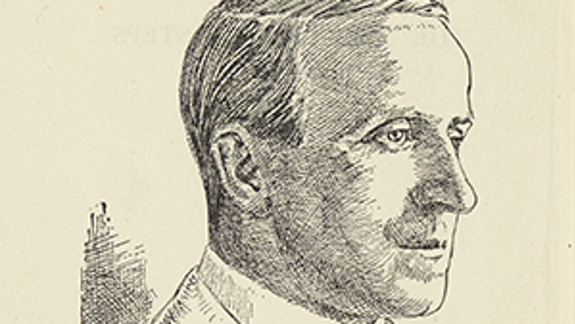
Literature and poetry
